The Role of Mild Alkaline Pretreatment in the Biorefinery Upgrade of Spent Coffee Grounds
Abstract
1. Introduction
2. Materials and Methods
2.1. Feedstock
2.2. Delignification and Post-Processing
2.3. Anaerobic Digestion Experiments
2.4. Analytical Methods
2.4.1. Quantification of Moisture and Ash Content
2.4.2. Quantification of Klason Lignin and Soluble Lignin in Biomass Samples
2.4.3. Quantification of Carbohydrates
2.4.4. High-Performance Size Exclusion Chromatography Analysis
2.4.5. Anaerobic Digestion Analysis
2.4.6. Statistical Analysis
3. Results and Discussion
3.1. SCG Chemical Composition
3.2. Mild Alkaline Pretreatment
3.2.1. Delignification of SCG
Molecular Weight of the Recovered Lignin
3.2.2. Oligosaccharides Production
3.2.3. Chemical Composition of MAP-SCG
3.3. Anaerobic Digestion
3.4. Overall Mass Balance
4. Conclusions
Supplementary Materials
Author Contributions
Funding
Institutional Review Board Statement
Informed Consent Statement
Data Availability Statement
Acknowledgments
Conflicts of Interest
References
- Battista, F.; Zuliani, L.; Rizzioli, F.; Fusco, S.; Bolzonella, D. Biodiesel, biogas and fermentable sugars production from spent coffee grounds: A cascade biorefinery approach. Bioresour. Technol. 2021, 342, 125952. [Google Scholar] [CrossRef] [PubMed]
- Teixeira, R.A.; Bueno, B.A.; Borges, R.M.; Bringhenti, J.R. Biochemical methane potential of spent coffee grounds via co-digestion with food waste. Bioenerg. Res. 2021, 1–12. [Google Scholar] [CrossRef]
- Stegmann, P.; Londo, M.; Junginger, M. The circular bioeconomy: Its elements and role in European bioeconomy clusters. Resour Conserv Recycl X 2020, 6, 100029. [Google Scholar] [CrossRef]
- Gebreeyessus, G.D. Towards the sustainable and circular bioeconomy: Insights on spent coffee grounds valorization. Sci. Total Environ. 2022, 833, 155113. [Google Scholar] [CrossRef]
- Obruca, S.; Benesova, P.; Kucera, D.; Petrik, S.; Marova, I. Biotechnological conversion of spent coffee grounds into polyhydroxyalkanoates and carotenoids. New Biotechnol. 2015, 32, 569–574. [Google Scholar] [CrossRef]
- Solomakou, N.; Loukri, A.; Tsafrakidou, P.; Michaelidou, A.M.; Mourtzinos, I.; Goula, A.M. Recovery of phenolic compounds from spent coffee grounds through optimized extraction processes. Sustain. Chem. Pharm. 2022, 25, 100592. [Google Scholar] [CrossRef]
- Ballesteros, L.F.; Ramirez, M.J.; Orrego, C.E.; Teixeira, J.A.; Mussatto, S.I. Optimization of autohydrolysis conditions to extract antioxidant phenolic compounds from spent coffee grounds. J. Food Eng. 2017, 199, 1–8. [Google Scholar] [CrossRef]
- Ballesteros, L.F.; Teixeira, J.A.; Mussatto, S.I. Extraction of polysaccharides by autohydrolysis of spent coffee grounds and evaluation of their antioxidant activity. Carbohydr. Polym. 2017, 157, 258–266. [Google Scholar] [CrossRef] [PubMed]
- Stahl, H.; Turek, E. Acid-hydrolysis of spent coffee grounds to produce D-mannose and D-mannitol. In Proceedings of the Fourteenth International Conference on Coffee Science, San Francisco, CA, USA, 14–19 July 1991. [Google Scholar]
- Chiyanzy, I.; Brienzo, M.; García-Aparicio, M.; Agudelo, R.; Gorgens, J. Spent coffee ground mass solubilisation by steam explosion and enzymatic hydrolysis. J. Chem. Technol. Biot. 2015, 90, 449–458. [Google Scholar] [CrossRef]
- Girotto, F.; Lavagnolo, M.C.; Pivato, A. Spent coffee grounds alkaline pre-treatment as biorefinery option to enhance their anaerobic digestion yield. Waste Biomass Valor. 2018, 9, 2565–2570. [Google Scholar] [CrossRef]
- Oliva, A.; Tan, L.C.; Papirio, S.; Esposito, G.; Lens, P.N.L. Effect of methanol-organosolv pretreatment on anaerobic digestion of lignocellulosic materials. Renew Energ. 2021, 169, 1000–1012. [Google Scholar] [CrossRef]
- Hassan, M.; Ding, W.M.; Bi, J.H.; Mehryar, E.; Talha, Z.A.A.; Huang, H.Y. Methane enhancement through oxidative cleavage and alkali solubilization pre-treatments for corn stover with anaerobic activated sludge. Bioresour. Technol. 2016, 200, 405–412. [Google Scholar] [CrossRef]
- Padilla-Rascón, C.; Carvalheiro, F.; Duarte, L.C.; Roseiro, L.B.; Ruíz, E.; Castro, E. An integrated olive stone biorefinery based on a two-step fractionation strategy. Ind. Crops Prod. 2022, 187, 115157. [Google Scholar] [CrossRef]
- Sambusiti, C.; Monlau, F.; Ficara, E.; Carrere, H.; Malpei, F. A comparison of different pre-treatments to increase methane production from two agricultural substrates. Appl. Energ. 2013, 104, 62–70. [Google Scholar] [CrossRef]
- Paudel, S.R.; Banjara, S.P.; Choi, O.K.; Park, K.Y.; Kim, Y.M.; Lee, J.W. Pretreatment of agricultural biomass for anaerobic digestion: Current state and challenges. Bioresour. Technol. 2017, 245, 1194–1205. [Google Scholar] [CrossRef] [PubMed]
- Shatalov, A.A.; Morais, A.R.C.; Duarte, L.C.; Carvalheiro, F. Selective single-stage xylan-to-xylose hydrolysis and its effect on enzymatic digestibility of energy crops giant reed and cardoon for bioethanol production. Ind. Crops Prod. 2017, 95, 104–112. [Google Scholar] [CrossRef]
- Juárez, G.F.Y.; Pabiloa, K.B.C.; Manlangit, K.B.L.; Go, A.W. Direct dilute acid hydrolysis of spent coffee grounds: A new approach in sugar and lipid recovery. Waste Biomass Valor. 2018, 9, 235–246. [Google Scholar] [CrossRef]
- Somnuk, K.; Eawlex, P.; Prateepchaikul, G. Optimization of coffee oil extraction from spent coffee grounds using four solvents and prototype-scale extraction using circulation process. Agric. Nat. Resour. 2017, 51, 181–189. [Google Scholar] [CrossRef]
- Atabani, A.E.; Ali, I.; Naqvi, S.R.; Badruddin, I.A.; Aslam, M.; Mahmoud, E.; Almomani, F.; Juchelkova, D.; Atelge, M.R.; Khan, T.M.Y. A state-of-the-art review on spent coffee ground (SCG) pyrolysis for future biorefinery. Chemosphere 2022, 286, 131730. [Google Scholar] [CrossRef]
- Vasmara, C.; Marchetti, R. Spent coffee grounds from coffee vending machines as feedstock for biogas production. Environ. Eng. Manag. J. 2018, 17, 2401–2408. [Google Scholar]
- Limousy, L.; Jeguirim, M.; Dutournie, P.; Kraiem, N.; Lajili, M.; Said, R. Gaseous products and particulate matter emissions of biomass residential boiler fired with spent coffee grounds pellets. Fuel 2013, 107, 323–329. [Google Scholar] [CrossRef]
- Girotto, F.; Pivato, A.; Cossu, R.; Nkeng, G.E.; Lavagnolo, M.C. The broad spectrum of possibilities for spent coffee grounds valorisation. J. Mater. Cycles Waste 2018, 20, 695–701. [Google Scholar] [CrossRef]
- van Dam, J.E.; Harmsen, P. Coffee Residues Utilization; Wageningen UR-Food & Biobased Research: Wageningen, The Netherlands, 2010.
- Chandra, R.; Takeuchi, H.; Hasegawa, T. Methane production from lignocellulosic agricultural crop wastes: A review in context to second generation of biofuel production. Renew Sust. Energ. Rev. 2012, 16, 1462–1476. [Google Scholar] [CrossRef]
- Mahmoud, E.; Atabani, A.E.; Badruddin, I.A. Valorization of spent coffee grounds for biogas production: A circular bioeconomy approach for a biorefinery. Fuel 2022, 328, 125296. [Google Scholar] [CrossRef]
- Kim, D.; Kim, H.; Kim, J.; Lee, C. Co-feeding spent coffee grounds in anaerobic food waste digesters: Effects of co-substrate and stabilization strategy. Bioresour. Technol. 2019, 288, 121594. [Google Scholar] [CrossRef]
- Orfanoudaki, A.; Makridakis, G.; Maragkaki, A.; Fountoulakis, M.S.; Kallithrakas-Kontos, N.G.; Manios, T. Anaerobic co-digestion of pig manure and spent coffee grounds for enhanced biogas production. Waste Biomass Valor. 2020, 11, 4613–4620. [Google Scholar] [CrossRef]
- Motte, J.C.; Trably, E.; Escudie, R.; Hamelin, J.; Steyer, J.P.; Bernet, N.; Delgenes, J.P.; Dumas, C. Total solids content: A key parameter of metabolic pathways in dry anaerobic digestion. Biotechnol. Biofuels 2013, 6, 164. [Google Scholar] [CrossRef] [PubMed]
- Sluiter, A.; Hames, B.; Ruiz, R.; Scarlata, C.J.; Sluiter, J.; Templeton, D. Determination of Sugars, Byproducts, and Degradation Products in Liquid Fraction Process Samples; NREL/TP-510-42623; National Renewable Energy Laboratory: Golden, CO, USA, 2008. [Google Scholar]
- Pedersen, M.; Meyer, A.S. Lignocellulose pretreatment severity—Relating pH to biomatrix opening. New Biotechnol. 2010, 27, 739–750. [Google Scholar] [CrossRef] [PubMed]
- Sluiter, A.; Hames, B.; Ruiz, R.; Scarlata, C.J.; Sluiter, J.; Templeton, D. Determination of Ash in Biomass; NREL/TP-510-42622; National Renewable Energy Laboratory: Golden, CO, USA, 2008.
- Sluiter, A.; Hames, B.; Ruiz, R.; Scarlata, C.; Sluiter, J.; Templeton, D.; Crocker, D. Determination of Structural Carbohydrates and Lignin in Biomass; NREL/TP-510-42618; National Renewable Energy Laboratory: Golden, CO, USA, 2012.
- Moniz, P.; Serralheiro, C.; Matos, C.T.; Boeriu, C.G.; Frissen, A.E.; Duarte, L.C.; Roseiro, L.B.; Pereira, H.; Carvalheiro, F. Membrane separation and characterisation of lignin and its derived products obtained by a mild ethanol organosolv treatment of rice straw. Process Biochem. 2018, 65, 136–145. [Google Scholar] [CrossRef]
- Standard Methods Committee of the American Public Health Association; American Water Works Association; Water Environment Federation. Standard Methods for the Examination of Water and Wastewater; American Public Health Association: Washington, DC, USA, 2017. [Google Scholar]
- Buchauer, K. A comparison of two simple titration procedures to determine volatile fatty acids in influents to waste-water and sludge treatment processes. Water SA 1998, 24, 49–56. [Google Scholar]
- Mussatto, S.I.; Machado, E.M.S.; Martins, S.; Teixeira, J.A. Production, composition, and application of coffee and its industrial residues. Food Bioprocess Technol. 2011, 4, 661–672. [Google Scholar] [CrossRef]
- Ballesteros, L.F.; Teixeira, J.A.; Mussatto, S.I. Chemical, functional, and structural properties of spent coffee grounds and coffee silverskin. Food Bioprocess Technol. 2014, 7, 3493–3503. [Google Scholar] [CrossRef]
- Branco, P.C.; Dionisio, A.M.; Torrado, I.; Carvalheiro, F.; Castilho, P.C.; Duarte, L.C. Autohydrolysis of Annona cherimola mill. seeds: Optimization, modeling and products characterization. Biochem. Eng. J. 2015, 104, 2–9. [Google Scholar] [CrossRef]
- Yuan, Z.Y.; Wen, Y.B.; Kapu, N.S. Ethanol production from bamboo using mild alkaline pre-extraction followed by alkaline hydrogen peroxide pretreatment. Bioresour. Technol. 2018, 247, 242–249. [Google Scholar] [CrossRef]
- Silverstein, R.A.; Chen, Y.; Sharma-Shivappa, R.R.; Boyette, M.D.; Osborne, J. A comparison of chemical pretreatment methods for improving saccharification of cotton stalks. Bioresour. Technol. 2007, 98, 3000–3011. [Google Scholar] [CrossRef]
- Du, B.Y.; Zhu, H.W.; Wang, X.; Xiao, L.P.; Ma, J.L.; Chen, X.H.; Zhou, J.H.; Sun, R.C. Tuning structure of spent coffee ground lignin by temperature fractionation to improve lignin-based carbon nanofibers mechanical performance. Int. J. Biol. Macromol. 2021, 174, 254–262. [Google Scholar] [CrossRef]
- Jin, H.Q.; Shi, H.Q.; Jia, W.C.; Sun, Y.N.; Sheng, X.R.; Guo, Y.Z.; Li, H.M.; Sun, H.D. Green solvents-based molecular weight controllable fractionation process for industrial alkali lignin at room temperature. Int. J. Biol. Macromol. 2022, 207, 531–540. [Google Scholar] [CrossRef] [PubMed]
- Moniz, P.; Pereira, H.; Quilhó, T.; Carvalheiro, F. Characterisation and hydrothermal processing of corn straw towards the selective fractionation of hemicelluloses. Ind. Crops Prod. 2013, 50, 145–153. [Google Scholar] [CrossRef]
- Duarte, L.C.; Carvalheiro, F.; Neves, I.; Girio, F.M. Effects of aliphatic acids, furfural, and phenolic compounds on Debaryomyces hansenii CCMI 941. Appl. Biochem. Biotechnol. 2005, 121, 413–425. [Google Scholar] [CrossRef]
- Duarte, L.C.; Carvalheiro, F.; Tadeu, J.; Girio, F.M. The combined effects of acetic acid, formic acid, and hydroquinone on Debaryomyces hansenii physiology. Appl. Biochem. Biotechnol. 2006, 130, 461–475. [Google Scholar] [CrossRef]
- Knill, C.J.; Kennedy, J.F. Degradation of cellulose under alkaline conditions. Carbohydr. Polym. 2003, 51, 281–300. [Google Scholar] [CrossRef]
- Akyol, C. In search of the optimal inoculum to substrate ratio during anaerobic co-digestion of spent coffee grounds and cow manure. Waste Manag. Res. 2020, 38, 1278–1283. [Google Scholar] [CrossRef] [PubMed]
- Bernhard, D. Process Monitoring in Biogas Plants; IEA Bioenergy: Vienna, Austria, 2013. [Google Scholar]
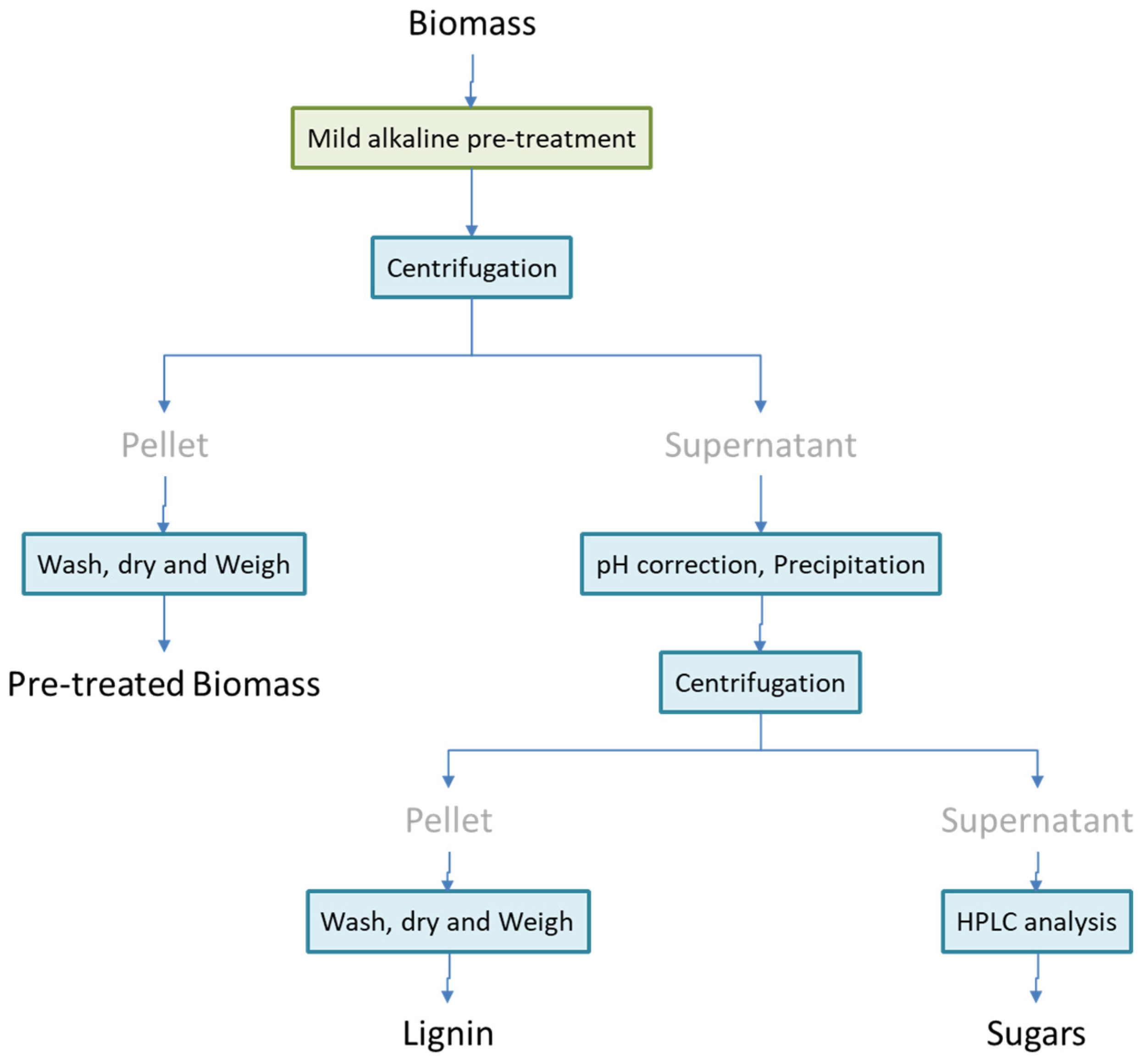

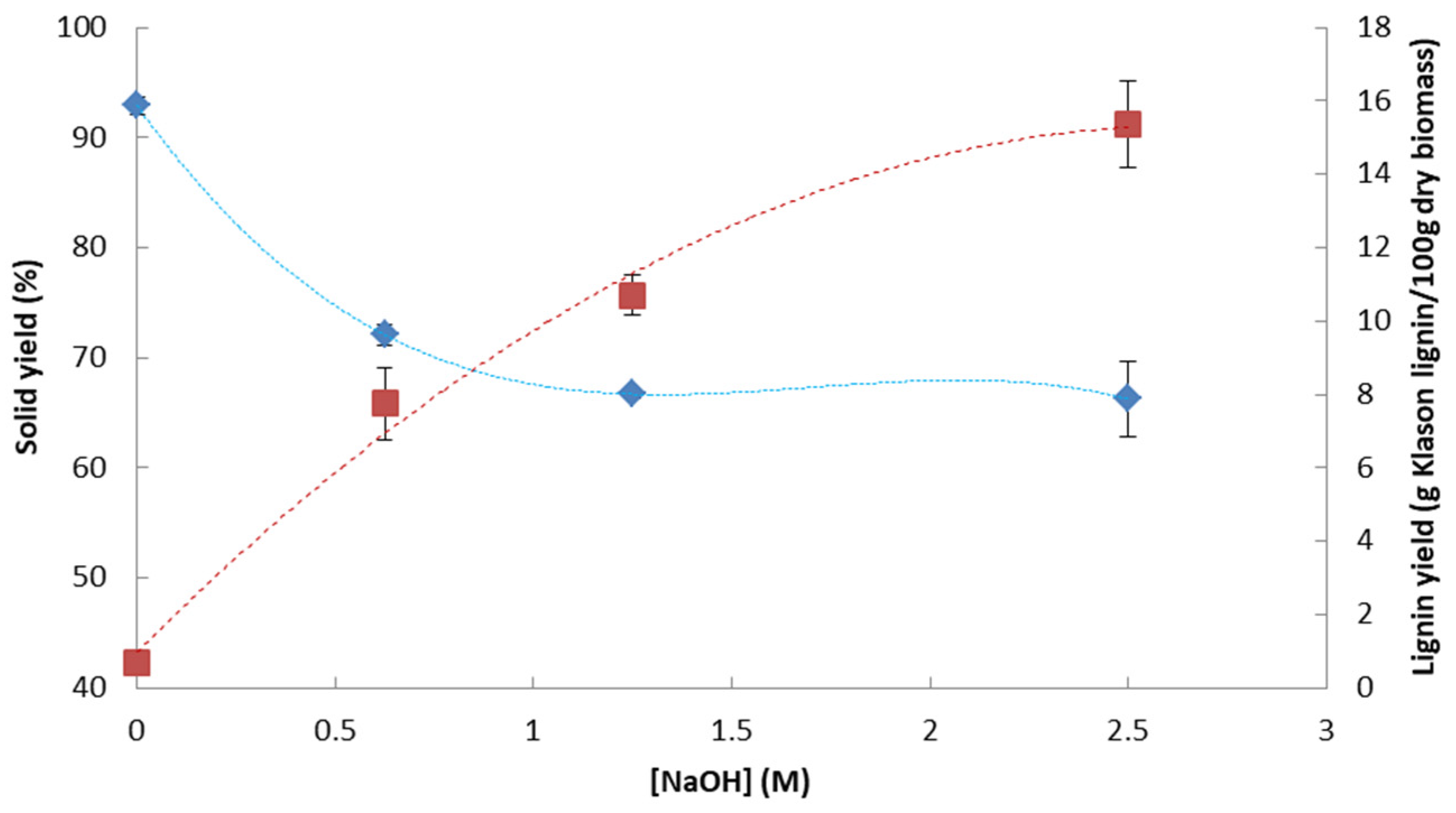
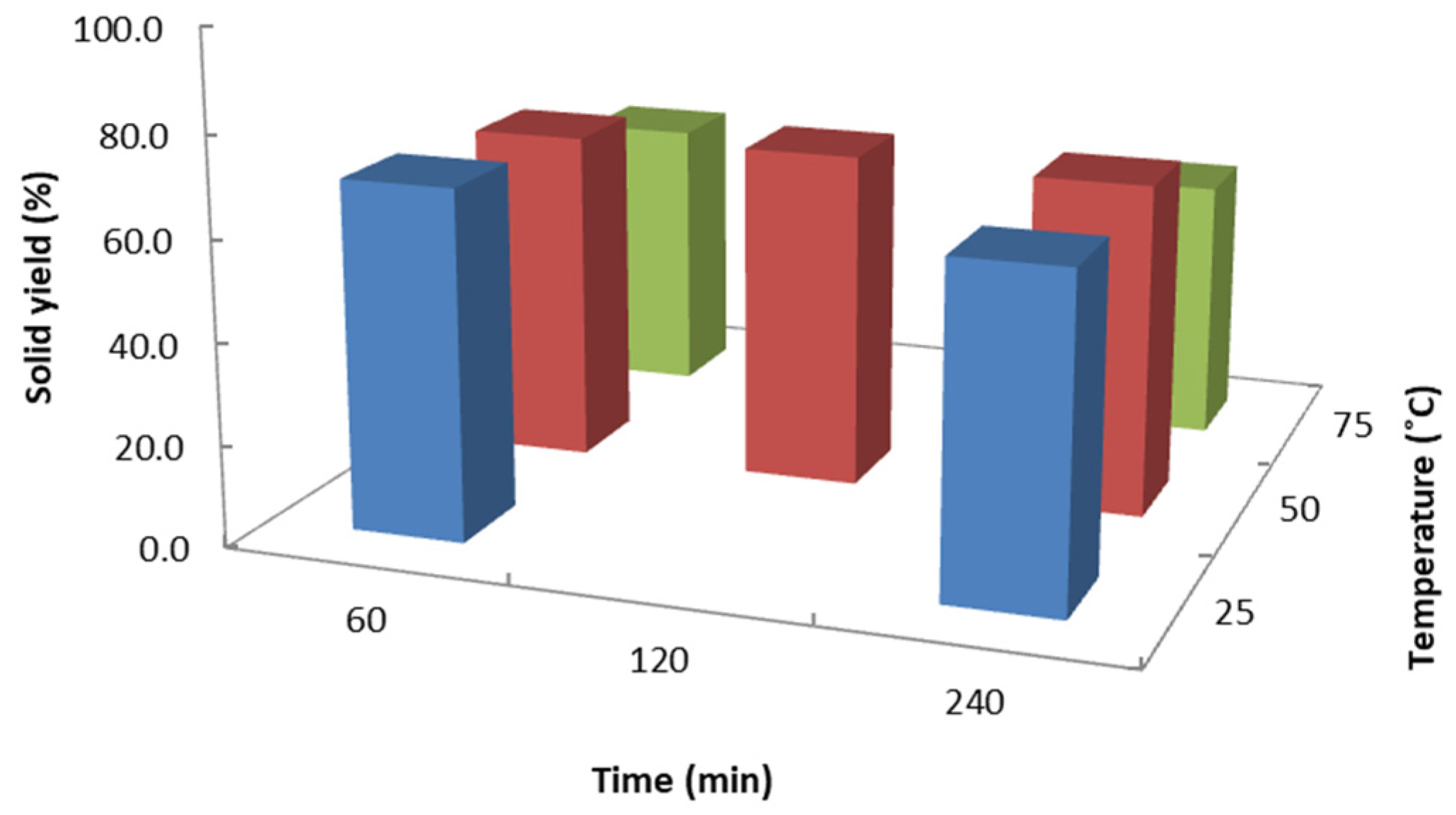
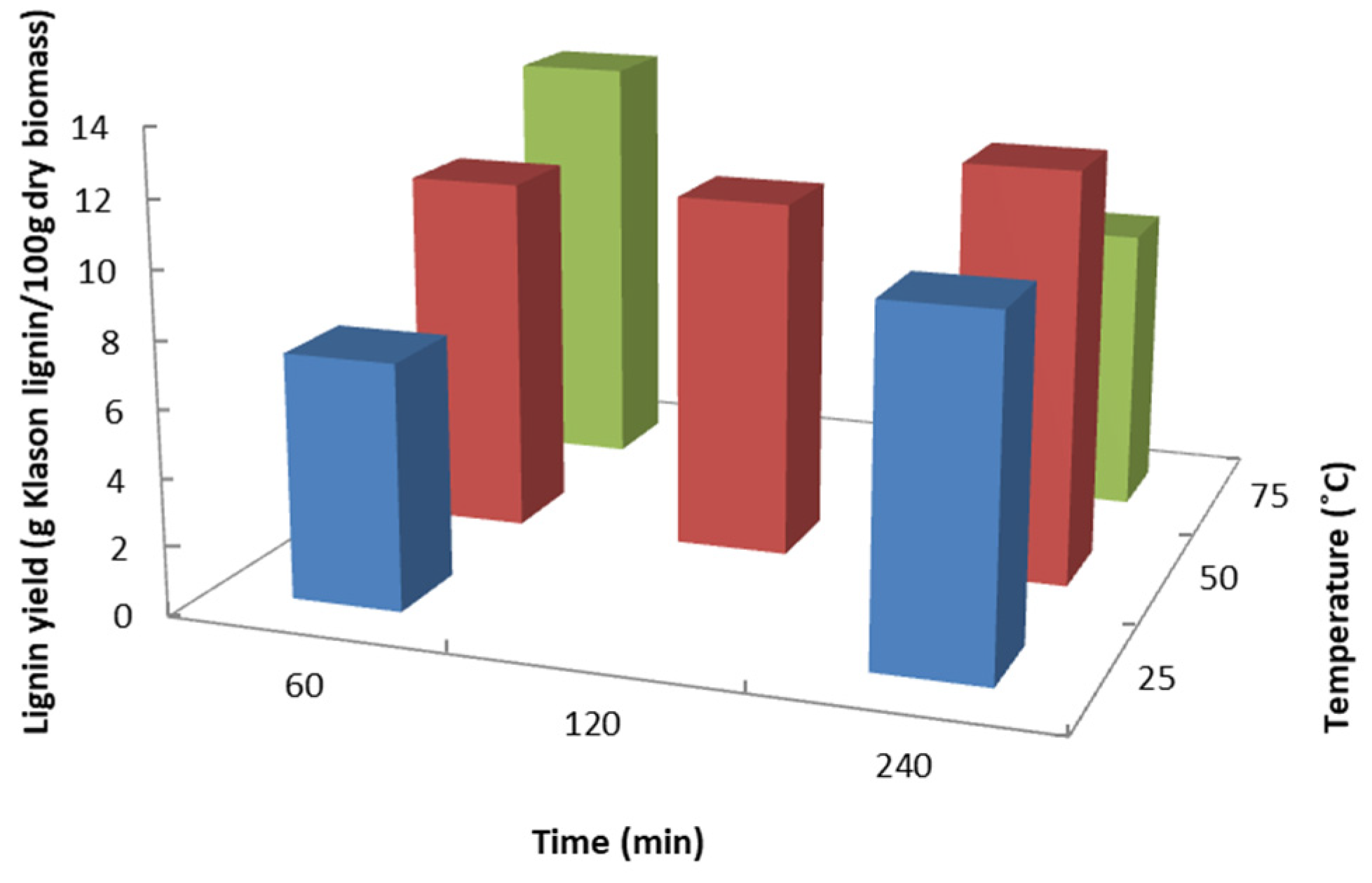
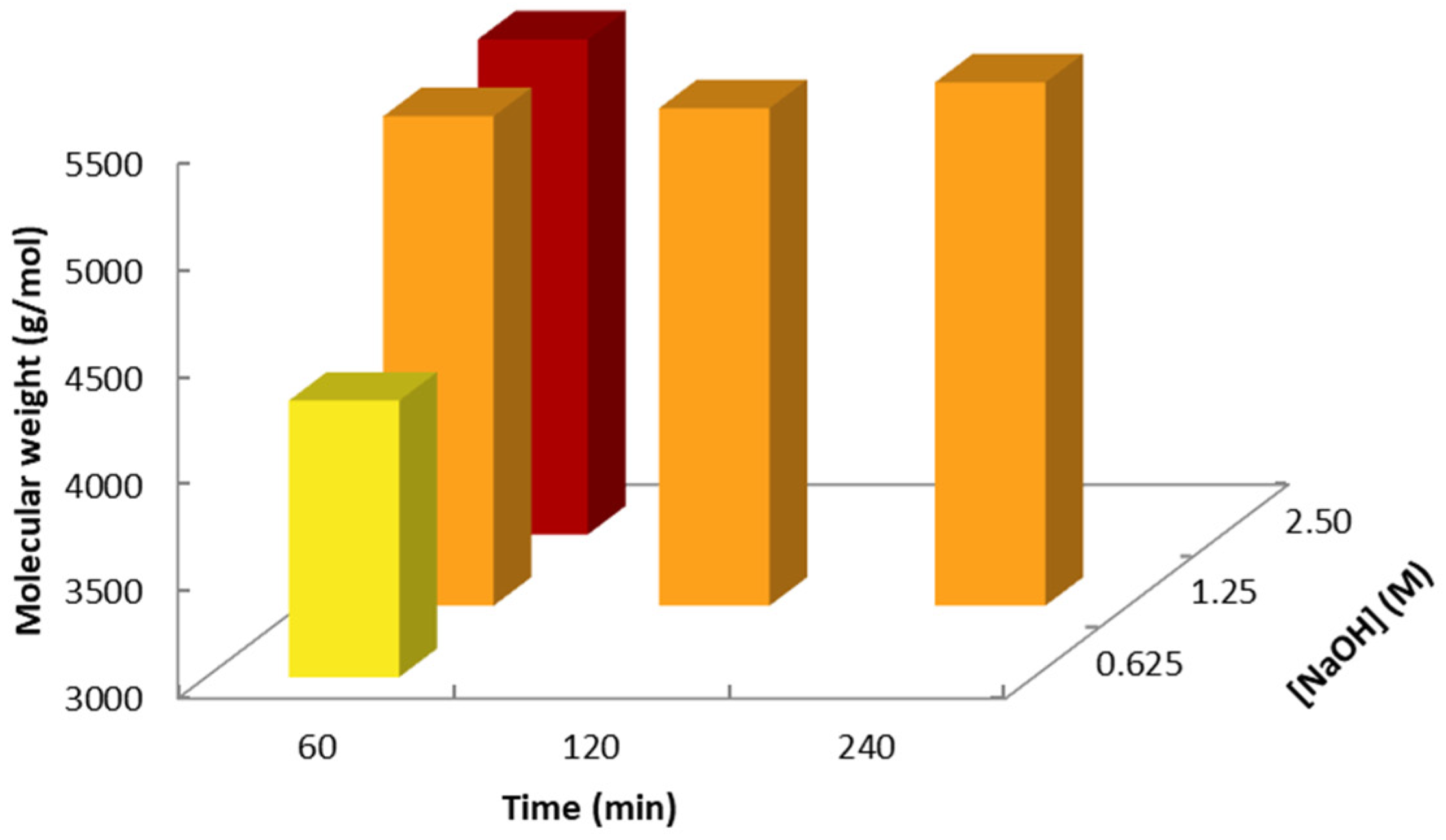
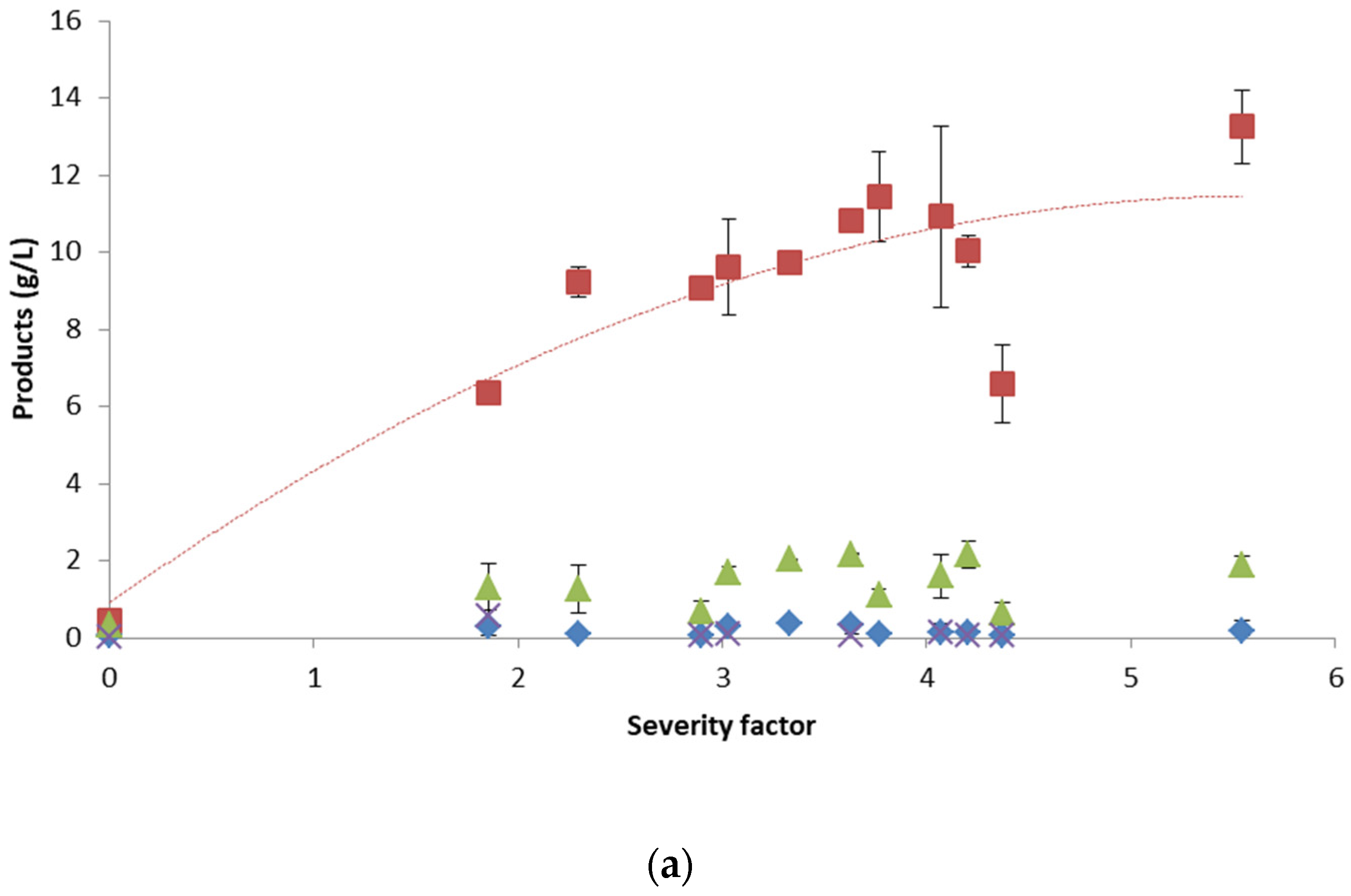
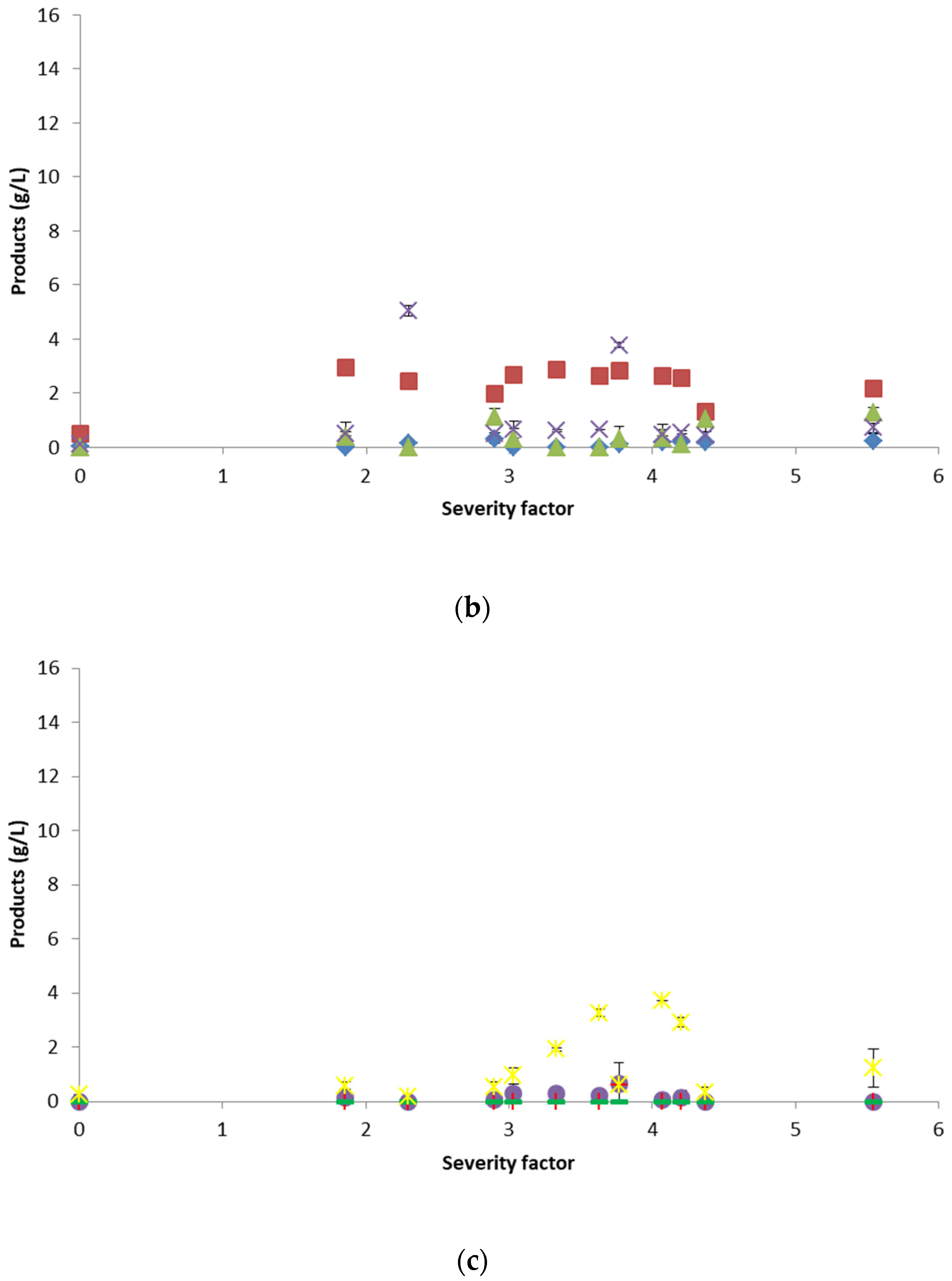

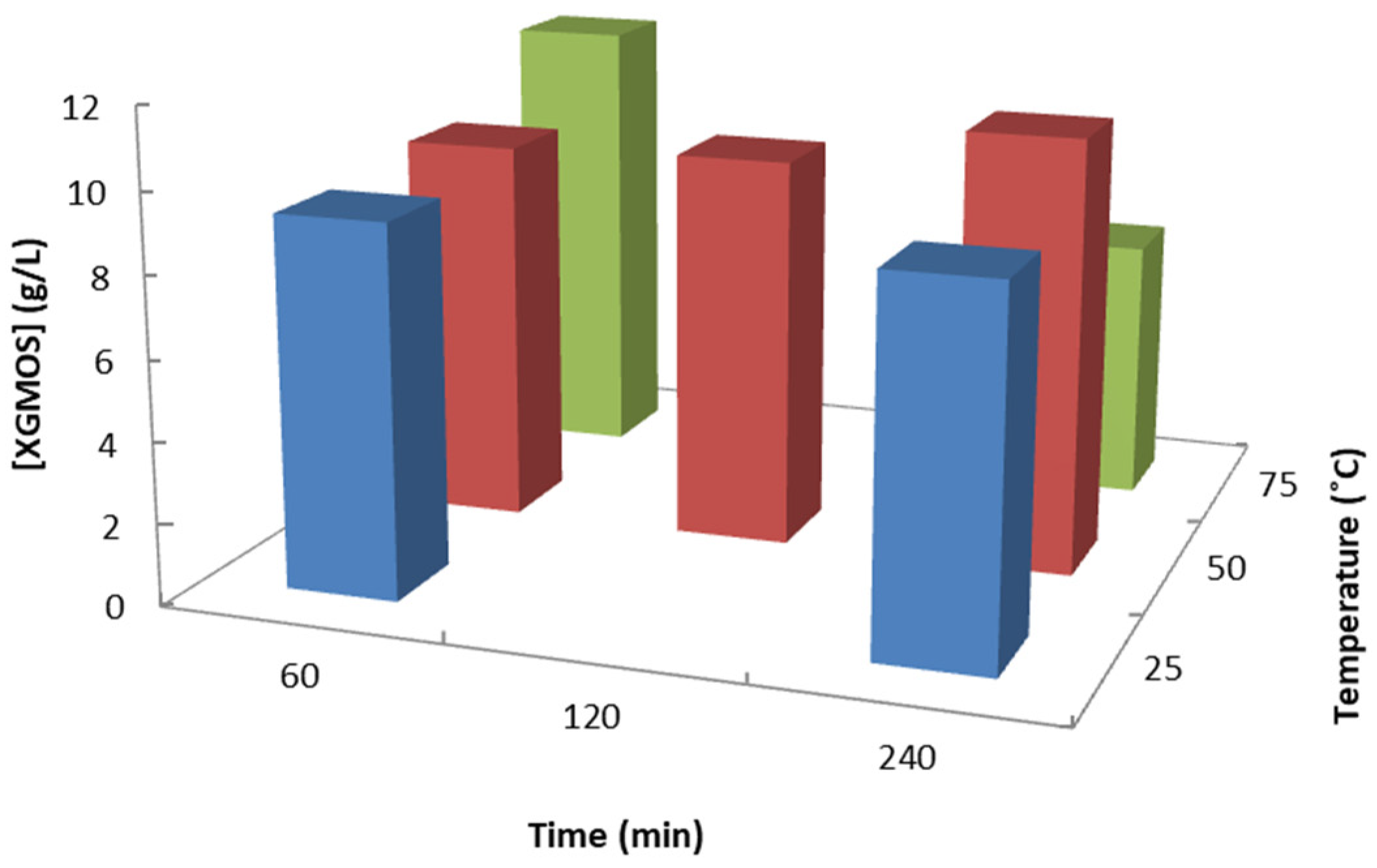

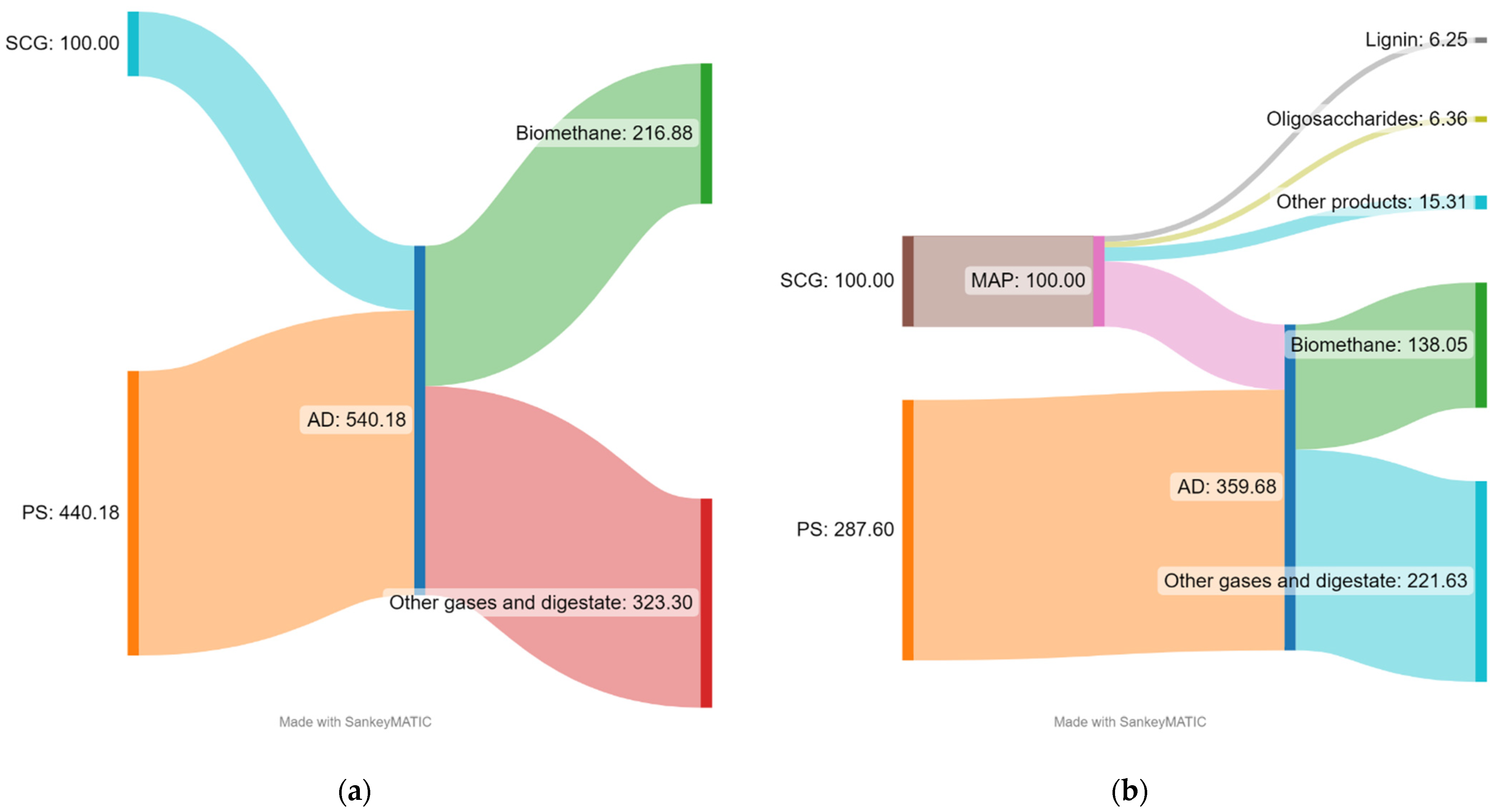
| Structural 1 | Extractable 1 | Total 1 | ||||
|---|---|---|---|---|---|---|
| Glucan | 10.22 | 0 | 9.55 | |||
| Hemicellulose | 39.84 | 9.16 | 49.00 | |||
| Arabinan | 2.40 | 1.93 | 4.33 | |||
| Xylogalactomannan 2 | 37.44 | 6.03 | 43.47 | |||
| Acetyl groups | 0.00 | 1.20 | 1.20 | |||
| Lignin | 15.77 | 14.96 | 30.73 | |||
| Klason Lignin | 15.30 | 13.29 | 28.59 | |||
| Soluble Lignin | 0.47 | 1.67 | 2.14 | |||
| Ash | 0.65 | 1.01 | 1.66 | |||
| Extractives | 0.00 | 19.70 | - | |||
| Water Extractives | 0.00 | 7.27 | - | |||
| Ethanol Extractives | 0.00 | 12.43 | - | |||
| Others (by difference) | - | - | 9.06 | |||
| Solid Yield | Lignin Yield | |||
|---|---|---|---|---|
| Parameter | Coefficients | p-Value | Coefficients | p-Value |
| β0 | 98.562 | 4.2 × 10−25 | 2.231 | 0.086 |
| β1 | −0.056 | 2.4 × 10−5 | 0.001 | 0.789 |
| β2 | −9.607 | 1.9 × 10−7 | 4.965 | 6.6 × 10−11 |
| β3 | −0.261 | 1.7 × 10−5 | 0.023 | 0.223 |
| Coefficients | p-Value | |
|---|---|---|
| β0 | 8.151 | 2.4 × 10−24 |
| β1 | 0.409 | 0.005 |
| β2 | 4.042 | 2.2 × 10−8 |
| β3 | −0.215 | 0.629 |
| MAP-SCG Structural Composition | ||
|---|---|---|
| Glucan | 12.66 ± 0.09 | |
| Hemicelulose | 51.23 ± 1.09 | |
| Arabinan | 6.46 ± 0.16 | |
| Xylogalactomannan | 44.77 ± 0.93 | |
| Acetyl groups | 0.00 ± 0.00 | |
| Lignin | 21.29 ± 0.28 | |
| Klason lignin | 20.74 ± 0.31 | |
| Soluble lignin | 0.55 ± 0.04 | |
| Ash | 6.58 ± 0.23 | |
| Others (by difference) | 8.24 | |
| Parameter | PS + SCG | PS + MAP-SCG |
|---|---|---|
| TS (g/L) | 9.98 ± 0.16 | 9.69 ± 0.34 |
| TDS (g/L) | 3.13 ± 0.06 | 3.07 ± 0.02 |
| VS (g/L) | 7.43 ± 0.19 | 7.13 ± 0.40 |
| VDS (g/L) | 1.72 ± 0.01 | 1.65 ± 0.01 |
| pH | 6.94 | 6.96 |
| EC (mS/cm) | 6.69 | 6.57 |
| CODT (g/L) | 11.25 | 11.50 |
| CODS (g/L) | 10.75 | 11.25 |
Disclaimer/Publisher’s Note: The statements, opinions and data contained in all publications are solely those of the individual author(s) and contributor(s) and not of MDPI and/or the editor(s). MDPI and/or the editor(s) disclaim responsibility for any injury to people or property resulting from any ideas, methods, instructions or products referred to in the content. |
© 2023 by the authors. Licensee MDPI, Basel, Switzerland. This article is an open access article distributed under the terms and conditions of the Creative Commons Attribution (CC BY) license (https://creativecommons.org/licenses/by/4.0/).
Share and Cite
Ribeiro, G.M.; Martins, P.L.; Oliveira, A.C.; Carvalheiro, F.; Fragoso, R.; Duarte, L.C. The Role of Mild Alkaline Pretreatment in the Biorefinery Upgrade of Spent Coffee Grounds. Energies 2023, 16, 3907. https://doi.org/10.3390/en16093907
Ribeiro GM, Martins PL, Oliveira AC, Carvalheiro F, Fragoso R, Duarte LC. The Role of Mild Alkaline Pretreatment in the Biorefinery Upgrade of Spent Coffee Grounds. Energies. 2023; 16(9):3907. https://doi.org/10.3390/en16093907
Chicago/Turabian StyleRibeiro, Gabriel Mota, Pedro L. Martins, Ana Cristina Oliveira, Florbela Carvalheiro, Rita Fragoso, and Luís C. Duarte. 2023. "The Role of Mild Alkaline Pretreatment in the Biorefinery Upgrade of Spent Coffee Grounds" Energies 16, no. 9: 3907. https://doi.org/10.3390/en16093907
APA StyleRibeiro, G. M., Martins, P. L., Oliveira, A. C., Carvalheiro, F., Fragoso, R., & Duarte, L. C. (2023). The Role of Mild Alkaline Pretreatment in the Biorefinery Upgrade of Spent Coffee Grounds. Energies, 16(9), 3907. https://doi.org/10.3390/en16093907








